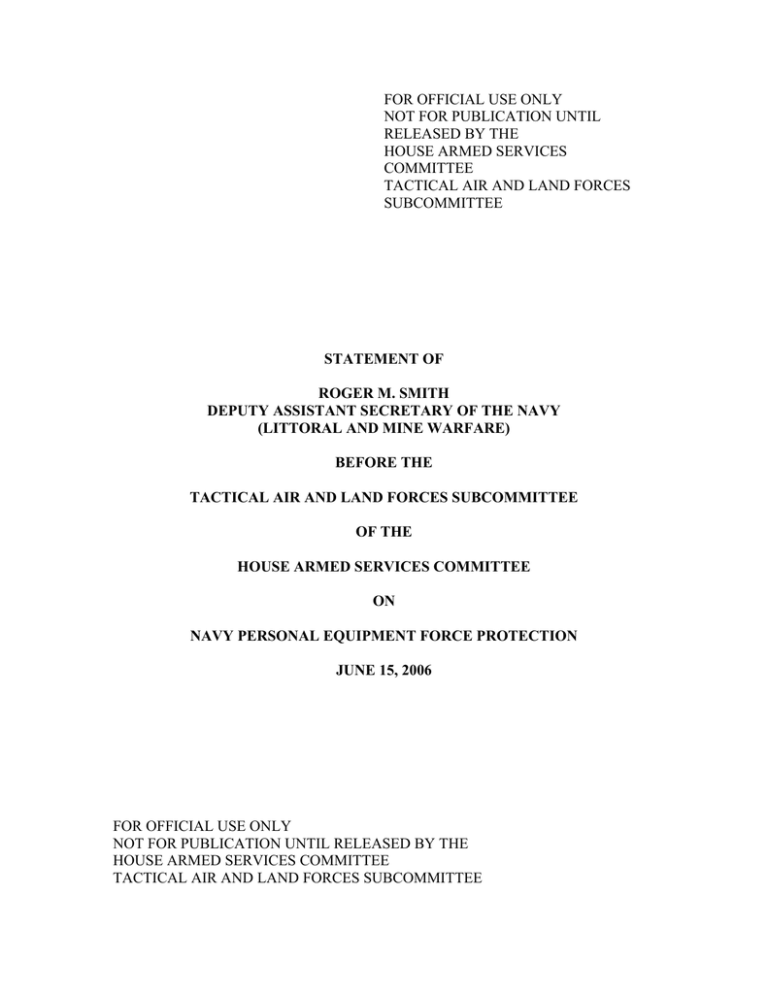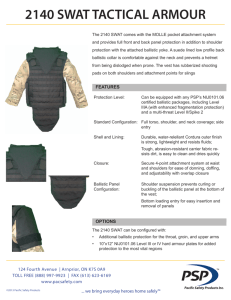FOR OFFICIAL USE ONLY NOT FOR PUBLICATION UNTIL RELEASED BY THE
advertisement

FOR OFFICIAL USE ONLY NOT FOR PUBLICATION UNTIL RELEASED BY THE HOUSE ARMED SERVICES COMMITTEE TACTICAL AIR AND LAND FORCES SUBCOMMITTEE STATEMENT OF ROGER M. SMITH DEPUTY ASSISTANT SECRETARY OF THE NAVY (LITTORAL AND MINE WARFARE) BEFORE THE TACTICAL AIR AND LAND FORCES SUBCOMMITTEE OF THE HOUSE ARMED SERVICES COMMITTEE ON NAVY PERSONAL EQUIPMENT FORCE PROTECTION JUNE 15, 2006 FOR OFFICIAL USE ONLY NOT FOR PUBLICATION UNTIL RELEASED BY THE HOUSE ARMED SERVICES COMMITTEE TACTICAL AIR AND LAND FORCES SUBCOMMITTEE Mr. Chairman and members of the subcommittee, thank you for the opportunity to appear before you today to discuss the Navy’s individual protection equipment (IPE) requirements and equipping process. The Navy procures and fields various IPE configurations based on our ashore and maritime mission requirements as defined by combatant commanders. These systems all provide a minimum of National Institute of Justice (NIJ) level IIIA ballistic protection. The Navy personnel deployed worldwide engaged in the Global War on Terror (GWOT) currently fluctuates around 10,000 personnel depending on unit rotations. About 79 percent of these personnel are deploying and supporting ground forces in their traditional military specialties, or core competencies ashore, such as base and port operations support, medical services, explosive ordnance disposal teams, construction and engineer battalions (Seabees), electronic warfare, mobile security forces, detainee operations, infrastructure protection, and traditional joint intelligence and staff support. Navy personnel fulfill four basic requirements; 1) unit or individual, 2) active component (AC) / reserve component (RC) or a blended AC/RC mix, 3) joint requirements or internal Navy requirements; and 4) pre-planned, existing structure or ad-hoc needs. Navy personnel are equipped with IPE appropriate for the required mission that the individual or the unit they are assigned will perform. The Navy acquires IPE for three main mission requirements: 1.) Navy expeditionary forces; 2 2.) Individual augmentees assigned to joint forces; and, 3.) Shipboard anti-terrorism. 1. NAVY EXPEDITIONARY FORCES Navy expeditionary forces primarily comprise the core missions of Naval Construction Forces (NCF), or Seabees, airlift support, cargo handling, maritime security, and medical / Marine Corps support. The IPE acquired for these personnel is procured through various buying agencies. NCF (Seabees) Determination of NCF requirements is a collaborative process between the First Naval Construction Division (Fleet), Naval Facilities Engineering Command (Systems Command), OPNAV N43 (Resource Sponsor), and the Naval Facilities Engineering Logistics Center (Table of Allowance (TOA) Managers). A Logistics Working Group meets quarterly to review and assess new requirement recommendations, which are based on research of industry product development, Department of Defense (DoD) standards, field testing results, and procurement options. Interoperability and commonality of products with the Marine Corps and /or the Army is maximized to the greatest extent possible. IPE is acquired and fielded in accordance with Task Force Commander Area of Operations Doctrine. Fielding of requirements is based on the Fleet’s prioritization of needs. 3 We currently have 1,800 Seabees deployed in the Central Command area of operations, with three quarters of those deployed to Operation Iraqi Freedom (OIF). These forces are typically on 179-day rotations into theater. NCF IPE Current IPE consists of “782 gear,” or fighting load, helmets and body armor. The NCF is researching new technologies to upgrade, modernize and provide maximum interoperability with the USMC and Army. Helmets The Seabees use the Personnel Armor System, Ground Troops (PASGT) Kevlar composite helmet up-graded with a Ballistic Liner Suspension System (BLSS). The BLSS was fielded as an upgrade to the helmet within the past 18 months as a result of feedback and post deployment lessons learned. The decision to upgrade the helmet versus procurement of the Army’s Advanced Combat Helmet (ACH) was determined through trade off analysis conducted to determine weight versus ballistic coverage benefits. The Kevlar helmet weighs approximately 3.4 lbs versus the ACH at 2.6 lbs, but provides over 10 % more front and side coverage than the ACH. The BLSS provides the same level of comfort and stability as the ACH and provides increased protection against blunt force trauma. It was also more cost effective to procure an upgraded suspension system versus a completely new helmet system and the NCF desired the additional ballistic coverage provided by the existing PASGT helmet. 4 Body Armor The NCF is currently outfitted with the standard Interceptor Outer Tactical Vest (OTV) with Small Arms Protective Insert (SAPI) plates, groin protector, throat protector and side plates for enhanced ballistic protection. Four thousand sets of side SAPI plates were ordered in March 2006 for delivery to units deployed in OIF. The SAPI plates for deployed forces have been replaced with enhanced SAPI (ESAPI) plates, of which 800 sets of ESAPI were ordered in March 2006 for deployed units in OIF. Additionally, a limited quantity of 100 sets of Quad Guard systems, which provide supplemental protection to exposed arms and legs were procured and deployed to OIF deployed units for evaluation. The Quad Guard system protects ground troops, stationary guard post or gunner’s positions. Non-NCF EXPEDITIONARY FORCES Requirements for non-NCF expeditionary personnel, such as, maritime security forces, are determined through the Navy’s requirements generation process. The Navy’s Program Executive Officer (PEO) (Littoral and Mine Warfare) is the central procuring agent for these fleet requirements. For example, the PEO (LMW) is the procurement agent for IPE for Naval Coastal Warfare (NCW) squadrons and these units field the IPE to the assigned personnel. These personnel typically wear the “RBR” (contractor’s name) helmet rigged with a standard, four-point fully adjustable suspension system or an optional mil-spec padded suspension system. The helmet is comparable to the Army’s ACH with its higher cut around the neck, which provides more head movement, 5 peripheral vision, and operation of communications systems and weighs 2.6 – 2.9 pounds. NCW personnel wear a lightweight, modified Interceptor Body Armor OTV with “GAMMA-L” (contractor’s name) front, back and side panel ballistic plates. These OTVs incorporate a floatation collar for buoyancy and a quick release mechanism for jettisoning the ballistic plates to reduce the vest’s weight if an individual wearing the vest experiences an unplanned water entry. The vest is adjustable via shoulder straps with removable front and back soft ballistic panels and offers the option to attach additional groin, throat and shoulder panels. The GAMMA-L ballistic plates provide NIJ level IV protection and are an alternative source the Navy developed due to the limited availability of ESAPI plates. MARINE CORPS EXPEDITIONARY FORCES SUPPORT PERSONNEL Navy medical, religious and other support personnel (e.g., doctors, dentists, corpsmen, chaplains, religious support personnel, etc.) assigned to our Marine Expeditionary Forces are provided the IPE the Marine Corps issues to its personnel and to the level of protection required by the units they are assigned to. 2. INDIVDUAL AUGMENTEES Individual augmentees (IAs) comprise the majority of the approximately 10,000 Navy personnel deployed in support of the GWOT. The IAs that will be assigned to specific Army units go through a 14 day pre-deployment training course at Fort Jackson, South Carolina. This Navy Individual Augmentee Combat Training curriculum was developed in coordination with the Army. Theater or mission specific training, which 6 IAs may require is determined by the combatant commander and the IAs receive it prior to deployment. Additionally, eight hours of online training on rights and responsibilities is required to be completed through Navy Knowledge Online prior to deployment. Approximately 360 IAs / month are trained at Fort Jackson. The Army’s PEO (Soldier) issues the standard Army IPE to Navy IAs at this site. Other “in lieu of” IAs, such as, supply clerks, electronics technicians, information technology technicians, etc., who will fill other joint force and staff theater requirements, are trained at other Army Training and Doctrine Command sites around the country depending on their specialty and receive a 14 day training profile as well. These IAs are trained and issued standard Army IPE at these sites. The Navy reimburses the Army for this gear. 3. SHIPBOARD ANTI-TERRORISM: SHIPBOARD IPE Officers and sailors wear the standard Army PASGT issue Kevlar composite helmet and “Point Blank,” (contractor’s name) concealable body armor IPE for shipboard internal security, general quarters and antiterrorism missions. The helmet is worn with the standard suspension system and provides the standard ballistic protection. The Point Blank ballistic vest can be worn under other uniform attire if required, provides extended length front and back coverage as well as side ballistic coverage. It allows for enhanced 7 chest coverage, is adjustable through elastic straps, has removable ballistic panels, and can accept front and back ballistic plates, which provide NIJ level IIIA protection. VISIT BOARD, SEARCH AND SEIZURE / ENHANCED MARITIME INTERCEPT OPERATIONS (VBSS / EMIO) Personnel conducting VBSS / EMIO wear uniquely-configured equipment due to the physical requirements of transferring between rigid hull inflatable boats and ships and vessels which are being boarded, as well as negotiating ladders and passageways while aboard the ship or vessel. The VBSS / EMIO teams wear the “RBR” (contractor’s name) tactical helmet and “London Bridge” (contractor’s name) ballistic tactical vest, which provides NIJ level III ballistic protection with front, back and side ballistic ceramic plates. The plates are neutrally buoyant for enhanced safety during water operations. The London Bridge ballistic tactical vest also acts as a floatation vest and is adjustable through elastic straps, which provide a firm and custom fit. The RBR helmet worn by these forces is the same helmet outlined earlier in the section titled “Non-NCF EXPEDITIONARY FORCES”. CONCLUSION The Navy procures and equips its forces with the best available IPE, tailored to our maritime and joint mission requirements and continues to conduct market analysis as required to make the resource sponsors and fleet knowledgeable of improvements in equipment. 8







